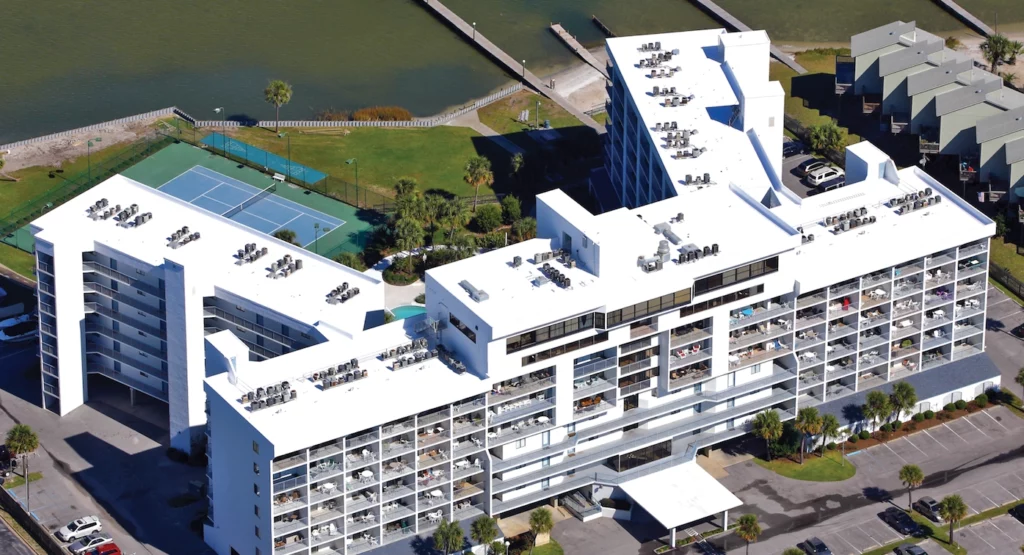Cool Roofs Offer Many Benefits for Commercial Facilities
Depending upon where you live in the United States (U.S.), the air temperature can soar up to 100 degrees on a hot, sunny day. When it gets this hot, some people have been reported to fry eggs on the sidewalk or cook cookies in their mailboxes. So just imagine what could be happening on top of your commercial roof when the temperature is this warm!

According to Energy Star, a program that promotes energy efficiency and is run by the U.S. Environmental Protection Agency and the U.S. Department of Energy, at noon on a clear summer day in the U.S., a flat (horizontal) surface (commercial roof) receives about 1,000 watts of sunlight per square meter, which is about 100 watts, or the power of a bright incandescent light bulb, per square foot. If the commercial roof is dark in color, it will absorb the sunlight, which will heat the building and surrounding air, making the inside of a commercial facility feel blistering. Hot, dark roofs also contribute to the urban heat island effect by warming the air flowing over the roof, which ultimately aids in global warming by radiating heat into the atmosphere.
If you want to make your commercial facility more comfortable for your employees and protect your product when the air temperature spikes, not to mention make your facility more energy efficient and environmentally friendly, you should consider installing a cool roof. The Cool Roof Rating Council defines a cool roof as a roof that strongly reflects sunlight (solar energy) and cools itself by efficiently emitting any heat that is absorbed. A cool roof should be made of a material or have a commercial roof coating that can lower the roof surface temperature, decreasing the amount of heat transferred into your commercial building.
There are two ways to make a roof cool. One way is to guarantee the roof can reflect away sunlight, which is known as solar reflectance. This ensures the temperature inside the building stays cooler. The second way is to have the roof release or emit heat (infrared radiation), which is known as high thermal emittance. The ideal cool roof will possess both high solar reflectance and high thermal emittance. Although lighter colored roofs tend to have the best solar reflectance and thermal emittance, new coating and material technologies now exist that use darker-colored pigments that work just as well.
When it comes to cool roofs, there are many different commercial building roof types that are available. However, the surface solar reflectance of the roofing product is the most important factor. Thankfully, most cool roofing products cost about the same as conventional roofing materials. The easiest and least expensive way to make your roof cool is to choose a cool covering during new construction or when your existing roof needs to be replaced. Certain types of roofing products can also be retrofitted with cool coatings.
Once you have decided to create a commercial cool roof, you should consider the following cool roofing options:
Color
White roofing products stay coolest in the sun, reflecting about 60 to 90 percent of sunlight. However, dark roofs can also be effective, because the solar reflectance of dark materials can be boosted by using special pigments (colorants). These cool-colored products typically reflect about 30 to 60 percent of the sunlight.
Asphalt Shingles
A shingle with light-colored or if a darker color is preferred, cool-colored granules will make your roof cool. Note: field-coating previously installed asphalt shingle roofs to make them cool can create moisture retention issues and may void the shingle manufacturer’s warranty, so it is not recommended.
Wood Shingles & Shakes
These materials are naturally “cool colored.”
Polymer Shingles
Choose a shingle that is factory-colored with light- or cool-colored pigments.
Clay Tiles
Terra cotta clay tiles or a clay tile with a factory-fired light- or cool-colored glaze will help achieve a cool roof. Glazed clay tiles can also be retrofitted with a field-applied light- or cool-colored polymer coating that is applied when the tiles are installed.
Concrete Tiles
Concrete is typically gray, but it is also available in other colors. Choosing a concrete tile with a factory-applied light or cool-colored slurry or polymer coating will make a roof cool. Concrete tiles can also be retrofitted with a field-applied light- or cool-colored polymer coating.
Metal Shingles or Tiles
Choose a metal shingle or tile that is factory coated with a light- or cool-colored paint or has a factory metal roof coating with reflective mineral granules. Metal shingles or tiles can be retrofitted with a field-applied paint, but an oven-baked factory-applied paint is more durable and economical.
Single-Ply Membranes
Choose a single-ply roof membrane that is factory colored with light- or cool-colored pigments or light-colored ballast.
Modified Bitumen Sheet Membranes
Select a cap sheet with a factory-applied reflective mineral surface or reflective coating.
Spray Polyurethane Foam
These protective coatings are usually already reflective and offer cool roof performance.
Installing a cool roof offers several benefits for both building owners and the environment. These benefits include:
- Keeping buildings cooler on hot days to improve indoor comfort and safety
- Decreasing the building’s air conditioning costs and reducing the strain on the electrical grid during peak energy demands
- Reducing pollution and greenhouse gas emissions associated with building energy use
- Diminishing the roof temperature, which can extend the life of the roof’s materials
- Contributing to lower temperatures in the surrounding air, which helps to reduce the urban heat island effect
- Providing financial savings through green/energy efficiency rebates and loans, as well as earning credits for cool roofs in green building programs
As you can see, there are many types of commercial roofs that can help you create a beneficial cool roof. To learn more about cool roofs or to get recommendations from a roofing professional on how to make your commercial facility more energy efficient, environmentally friendly, and comfortable, contact Capital Roof Care.
Sources:
https://www.energy.gov/energysaver/cool-roofs
https://coolroofs.org/resources/what-is-a-cool-roof